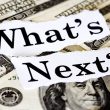by Collin Martin, Schwab Center for Financial Research
We are growing more cautious with high-yield bonds. While the higher yields they offer may seem attractive, risks are on the rise.
Economic growth is expected to slow this year compared to last, as indicated by the first-quarter Gross Domestic Product (GDP) report, which may weigh on corporate profits. Meanwhile, the Federal Reserve is planning an aggressive pace of rate hikes, which should result in tighter financial conditions and higher borrowing costs. Given those myriad risks, investors should proceed with caution with high-yield bonds. Volatility should remain elevated and prices may fall relative to Treasuries. With yields on higher quality investments up so much this year, we prefer investors move up in quality today and wait for better opportunities to take on more risk down the road.
We see four reasons why investors should proceed with caution:
1. Relative yields are still low.
Corporate bonds generally offer higher yields than Treasuries—called "credit spreads"—to compensate for the risk of lending to a corporation, like the risk of default. The risk of default tends to be higher with lower-rated bonds, like high-yield bonds. After all, they're called "junk" bonds for a reason.
Currently, investors aren't well compensated for those risks. The average option-adjusted spread of the Bloomberg U.S. Corporate High-Yield Bond Index is up sharply from the 2021 lows. After touching a post-pandemic low of just 2.62% last July, the average spread is now 3.88%. Despite the more than 100-basis-point rise, we believe investors should be compensated with even higher spreads to make up for the increasing risks in the market.
The prospect of higher spreads doesn't just mean that it may present investors a more attractive opportunity later on. Rising spreads also pose a risk to current bond holders, as those spreads could pull down the price of your junk bond investments.
High-yield spreads are still low

Source: Bloomberg, using daily data as of 5/2/2022. Bloomberg U.S. Corporate High-Yield Bond Index (LF98TRUU Index). Option-adjusted spreads are quoted as a fixed spread, or differential, over U.S. Treasury issues. OAS is a method used in calculating the relative value of a fixed income security containing an embedded option, such as a borrower's option to prepay a loan. Past performance is no guarantee of future results.
2. Borrowing costs are on the rise.
When junk bond yields rise, it becomes more expensive for issuers to borrow in the bond market. On the bright side, most high-yield bonds have fixed coupon rates, meaning their coupon rates are set at the time of issuance. If a company issued a fixed-rate junk bond with a five-year maturity last year, the recent rise in rates doesn't change the coupon rate paid today. Luckily there's not much debt coming due in the near-term. Of the $1.4 trillion outstanding bonds in the Bloomberg U.S. Corporate High-Yield Bond Index, only $170 billion, or 11% of the index, is scheduled to mature in the next three years.
Companies that need to issue debt today, however, are facing higher borrowing costs. That can be a problem for issuers looking to refinance debt that was issued at lower rates. As the chart below illustrates, the average yield of the high-yield bond index is now above the average coupon rate. That means that the cost of borrowing today (on average) is above the average rate paid by outstanding bonds—and companies that are refinancing now are likely refinancing at higher rates. (Keep in mind that we are referring to averages; the average yield or coupon rate can depend on factors such as maturity, credit quality, industry, etc.)
One concern for higher borrowing costs is the impact on corporate profits, discussed below.
The average yield of the high-yield bond index is now above the average coupon rate

Source: Bloomberg, using daily data as of 5/2/2022. Bloomberg U.S. Corporate High-Yield Bond Index (LF98TRUU Index). Past performance is no guarantee of future results.
3. Corporate profit growth is already slowing.
This trend started in the fourth quarter of 2021 and, based on 1Q22 earnings announcements, the trend appears to be continuing.
Rather than focus on individual corporate earnings announcements, we focus on corporate profit data from the Bureau of Economic Analysis (BEA). These numbers are based on the actual corporate production data used to compute GDP and offer a much more comprehensive look at corporate profits. While earnings from the members of the S&P 500 index are important, the corporate profit data from the BEA focuses on companies of all sizes, as well as both public and private companies.
In the fourth quarter of 2021, corporate profits grew just 0.7% for the quarter. The level of corporate profits is still high, so this isn't all doom and gloom. But trends matter, and if corporate growth continues to slow, investors may continue to demand higher spreads to lend to risky issuers. That can pull junk bond yields higher, and prices lower.

Source: Bloomberg, using quarterly data as of 4Q2021. US Corporate Profits With IVA and CCA Total SAAR (CPFTTOT Index). Note: Y-axis is truncated at 12%; actual increase for 3Q20 was 25%.
Some key risks for corporate profits and profit margins are the impact of inflation, supply chain issues, and borrowing costs. Rising borrowing costs via higher interest payments can eat into corporate profits. Meanwhile, wage gains are good for consumers, but can be a pain point for corporations, as it's another input cost on the rise.
Supply chain bottlenecks pose a risk for the high-yield market because issuers tend to have volatile cash flows or weak balance sheets even in good times—a few reasons why they have such low ratings in the first place. If disruptions in the supply chain prevent a company from providing a good or service, cash flows received from end customers would likely be delayed as well. When you couple that with rising input costs, like higher wages for employees, there could be less cash available to pay bondholders.
4. A flat or inverted yield curve usually spells trouble for high-yield bonds.
There's an old saying that, "When the Fed tightens, things break," and the high-yield bond market usually shows cracks as the Fed hikes rates—especially when the yield curve is flat or inverted.
There are many yield curve slopes out there, but two key slopes are the two-year/10-year Treasury slope and the three-month/10-year Treasury slope. Today, they are telling us different things. While the two-year/10-year slope is very flat, after briefly inverting in early April, the three-month/10-Year slope remains near its seven-year highs.
The two-year/10-year slope is flat while the three-month/10-year slope is steep

Source: Bloomberg, using daily data as of 4/28/2022. Market Matrix US Sell 3 Month & Buy 10 Year Bond Yield Spread (USYC3M10 Index) and Market Matrix US Sell 2 Year & Buy 10 Year Bond Yield Spread (USYC2Y10 Index). Past performance is no guarantee of future results.
Over time, high-yield bond total returns relative to Treasuries have been strongest when the yield curve is steep. As the curve flattens, and ultimately inverts, the relative return deteriorates. The table below compares the average 12-month total return of the Bloomberg U.S. Corporate High-Yield Bond Index relative to the Bloomberg U.S. Intermediate Treasury Index, depending on the starting slope of the two-year/10-year yield curve. When the slope is between zero and 100 basis points, the relative return is low but positive; when the slope is inverted, that average relative return plunges.
With the two-year/10-year curve at roughly 20 basis points today, caution is warranted.
High-yield bond returns tend to be low when the yield curve is flat or inverted

Source: Bloomberg. Relative returns compare the average 12-month total returns of the Bloomberg U.S. Corporate High-Yield Bond Index (LF98TRUU), Bloomberg Intermediate Treasury Index (LT08TRUU Index) and the Market Matrix US Sell 2 Year & Buy 10 Year Bond Yield Spread (USYC2Y10 Index) depending on the starting slope of the 2-year/10-year Treasury yield curves, using monthly data from January 1984 through March 2022. Past performance is no guarantee of future results.
The table below compares those same relative returns with the slope of the three-month/10-year Treasury yield curve. The takeaway is the same: when the yield curve flattens, returns tend to deteriorate.
The slope of the three-month/10-year Treasury curve is roughly 205 basis points today. But we believe it will flatten quickly as the Fed aggressively hikes rates this year. The 10-year Treasury yield may rise modestly higher from here, but the three-month Treasury yield is likely to rise much more. Based on market expectations for the pace of Fed rate hikes, this yield curve could be less than 100 basis points—or possibly inverted—by the end of the year.
Average high-yield relative returns have been negative when the 3-month/10-year slope is below 100 basis points.

Source: Bloomberg. Relative returns compare the average 12-month total returns of the Bloomberg U.S. Corporate High-Yield Bond Index (LF98TRUU), Bloomberg Intermediate Treasury Index (LT08TRUU Index) and the Market Matrix US Sell 2 Year & Buy 10 Year Bond Yield Spread (USYC2Y10 Index) depending on the starting slope of the 2-year/10-year Treasury yield curves, using monthly data from January 1984 through March 2022. Past performance is no guarantee of future results.
What to do now
Proceed with caution with high-yield bonds today. That doesn't mean abandoning your high-yield holdings, but investors who are overweight in high-yield bonds should consider paring back positions to an allocation that's more in line with long-term, strategic allocations.
High-yield bonds had been attractive over the past two years as most other bond yields were stuck near historic lows. But today there are ways to earn higher yields without taking on so much risk, as the chart below illustrates. The yields offered on many higher-rated bond investments aren't just up from the end of 2021, they're close to the highs of the past 10 years.
Intermediate-term investment grade corporates appear attractive today

Source: Bloomberg. As of 5/2/22. Indexes representing the investment types are: Bloomberg U.S. Aggregate Bond Index (LBUSYW Index), Bloomberg U.S. Treasury Index (LUACYW Index), Bloomberg U.S. Corporate Bond Index (LUACYW Index), Bloomberg U.S. Municipal Bond Index (LMBIYW Index), Bloomberg U.S. Corporate High-Yield Bond Index (LF98YW Index), Bloomberg Emerging Markets USD Aggregate Bond Index (EMUSYW Index), and the ICE BofA Fixed Rate Preferred Securities Index (P0P1 Index). Past performance is no guarantee of future results.
Given the storm clouds brewing, we think investors should take a more defensive approach to credit risk. Historically, the start of a rate hike cycle didn't end a credit market rally, but the end did. Even though the Fed has just started to hike rates, market expectations are pointing to a fast pace of hikes going forward, and the cycle may be over soon. We suggest you play a little defense now, as tighter financial conditions should lead to more volatility—and potential price declines—in the high-yield bond market.
Copyright © Schwab.com














